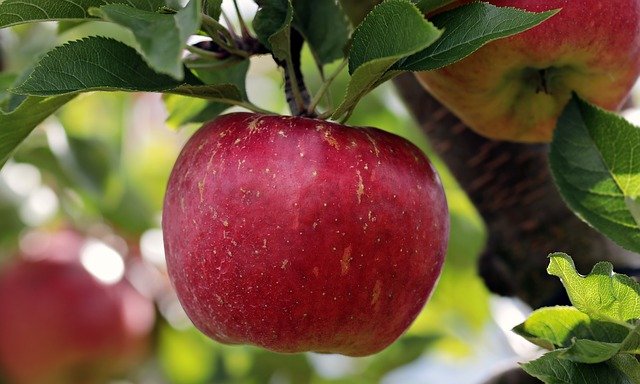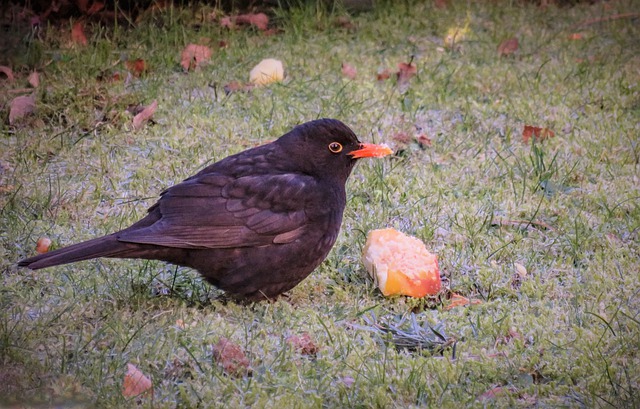Yes, Apples can indeed be a nutritious addition to the diet of many bird species.
These familiar fruits provide not only a source of natural sugars but also a host of essential nutrients.
However, a few guidelines should be followed when offering apples to our feathered friends.
Firstly, it’s important to wash the apples thoroughly to eliminate any traces of pesticides or contaminants that might be present on the skin.
Secondly, to facilitate easy consumption, slicing or chopping the apples into smaller, manageable pieces is recommended.
Birds have relatively small beaks, and smaller portions make it easier for them to feed.
Additionally, while the flesh of the apple is safe, it’s essential to remove the seeds before offering them to birds.
Apple seeds contain trace amounts of cyanide, which, although not usually harmful in small quantities, is best avoided.
As with any food, apples should be part of a diverse diet.
Birds require a mix of foods, including seeds, insects, fruits, and more, to thrive.
Offering apples can attract a variety of bird species, such as robins, bluebirds, and orioles, enhancing the diversity of your avian visitors.
So, remember to provide these crisp treats in moderation, supplementing them with other nutritious options to create a wholesome and balanced feeding experience for the birds in your area.
Are Apples Healthy for Birds?

Apples are particularly excellent for birds and wild garden birds, aside from being delicious and juicy, and should be included in a balanced, nutritious diet among other fruits and vegetables.
You should limit how often you feed wild and pet birds due to their high level of naturally occurring carbohydrates and huge water content.
If you’re buying apples expressly to feed birds, go for organic apples because they’re free of pesticides and are far healthier.
Apples Nutritional Values
| Calories | 95 kcal |
| Protein | 0.3 grams |
| Carbs | 25 grams |
| Fat | 0.2 grams |
| Fiber | 4 grams |
| Sugar | 10.4 grams |
| Vitamin C | 14% of the Reference Daily Intake (RDI) |
| Vitamin K | 5% of the RDI |
| Potassium | 6% of the RDI |
| Manganese | 4% of the RDI |
| Copper | 3% of the RDI |
Source: harvard.edu
How to Feed Apples to Birds?
First and foremost, before rinsing an apple under the tap, wash your hands.
Fruit washed under the faucet and subsequently handled with filthy hands has a slight advantage to birds.
After slicing the apple, remove the seeds because they contain tiny amounts of Cyanide and are toxic to all kinds of birds.
Apple cores are rarely eaten by birds.
Remove the body of the apple while removing the seeds.
Birds leave the heart behind after finishing the apple, bringing other animals such as rats and mice into your home.
Some birds don’t like the peel because it has a sourer flavor than the apple, while others will happily consume the entire slice.
Around an apple tree, a swarm of birds will naturally congregate.
You’ll notice that birds enjoy dining on it if you’re lucky enough to have one on your property.
Can Pet Birds Eat Apples?
Yes, As long as the apple is clean and hygienic, you can feed it to your pet bird by placing it between the cage bars, in a food bowl, or wherever else your bird would eat it.
Remove the apple after a few hours because it will quickly dry out and lose its flavor, taste, and nutritional value.
Can Wild Birds Eat Apples?
Putting a few larger pieces on your grass and finely cut pieces of apples on a bird table would suffice.
You can also cut the apple in half, remove the pips, then stake it on a limb or spike for birds to land nearby and gnaw at the luscious flesh.
Types of Apple Birds Like To Eat
There isn’t an apple that a bird doesn’t like.
If one apple isn’t appealing to a bird, try substituting another.
As a result, birds will happily consume apples, particularly crab apples and cooking apples.
Are Apples Beneficial to Birds?

Because apples are both nutritious and delicious, they are an ideal addition to a bird’s diet.
Furthermore, apples are beneficial to all birds.
Apples are an excellent source of fiber as well.
For digestion purposes, both humans and birds are encouraged to eat their fair share.
An apple is an excellent way to meet your daily fiber requirements.
Birds are always vulnerable to the hazards of nature as they travel, but they can maintain their strength by eating enough protein.
Apples are high in protein, which aids in the development of strong muscles and tissue.
They’ll also be given Vitamin A, which will aid their vision while flying across the air.
They’ll also receive Vitamin C, which will aid them in dealing with stress.
The magnesium in the apple helps the bird’s heartbeat faster and its brain to work more efficiently.
It will protect them from illness and enhance their natural abilities.
Apples are one of the healthiest snacks you can give a bird in your yard, and as time goes on, you’ll notice more visitations.
Ensure that the apples are available throughout peak feeding times and that any rotten apples are removed before the day ends.
You want to provide the freshest and healthiest foods for your birds.
You may always dump the apples on the ground or feed them from a bird feeder in your yard.
A bird feeder will keep them safe from ground predators while letting you view them from your favorite perch.
Some birds may even prefer insects over fruits.
If this happens, don’t be alarmed; you’ll need to figure out why birds are rejecting your apples.
Do Birds Eat Apples in Winter?

Fruit-eating birds migrate to warmer climates throughout the winter.
Those who live in snowy places can enjoy them throughout the year.
They don’t simply consume apples; they also devour oranges, bananas, grapes, and other fruits.
The sapsuckers, in particular, come to the garden in the winter.
Both varieties of apples hanging on the tree are edible to sapsuckers, both fresh and ripened.
You can feed chopped apples to birds or use various methods to change their shape.
Spread peanut butter on a tree trunk to create peanut pieces.
Pour melted suet into an ice cube tray to harden the texture.
When the surface of the tray is ready to change from melted to solid, take it out of the freezer.
Then, if desired, add apple pieces and other bird food.
Once you’ve added it, return the ice cube pan to the freezer to harden it.
Once you’ve finished, your cubed bird food will be ready.
Fruits with higher water content, such as pears and apples, may be a great source of nutrition for birds, and they also contain a lot of sugar, which keeps them active.
After being cut in half, these fruits can be placed on the bird table or even on the floor as food for the birds.
Birds such as blackbirds, waxwings, thrushes, and robins eat these fruits.
Birds have a difficult time surviving in the winter.
It’s even more difficult for small birds because their bodies are light compared to their size.
Thus they dissipate heat quickly to compensate for the heat loss.
Are Apples Toxic to Birds?
No, Apples are not poisonous to birds, but if they ingest the seeds, they become contaminated.
After feeding apples to any bird breed, no one has died or developed any health problems.
The rationale is simple: before presenting an apple to any bird, remove the seeds.
Also, take extra precautions when offering food to birds.
The apple seed does not kill the bird, but it is hazardous since it contains Amygdalin, albeit in tiny amounts.
Amygdalin, on the other hand, includes a minimal quantity of Cyanide.
Fruits are popular among birds, but some are safe for them while others are not.
Some fruits, such as apples and pears, and pits such as apricots, cherries, and peaches, contain a small amount of cardio-toxic Cyanide.
Also, it would be best to avoid any of the fruits mentioned earlier with sources, and you should remove any seeds before feeding birds.
If you are interested then check out these articles, Can Parakeets Eat Apples? or Can Cockatiels Eat Apples?
Final Words
In conclusion, the question of whether birds can eat apples is met with a resounding affirmative.
Apples, a common and nutrient-rich fruit, can indeed be a valuable addition to the diet of many bird species.
By adhering to some basic guidelines, such as washing the apples thoroughly, slicing them into manageable pieces, and removing the seeds, you can provide a safe and enjoyable treat for your feathered visitors.
As with any aspect of bird feeding, moderation is key.
Apples should complement a diverse and balanced diet that includes seeds, insects, and other bird-friendly foods.
By offering apples in addition to these nutritional sources, you’re not only catering to the dietary needs of various bird species but also enriching the biodiversity of your backyard.
So, delight in watching your avian companions relish these nutritious morsels while contributing to their well-being in a thoughtful and responsible manner.
FAQ
Which birds can eat apples?
Birds such as robins, bluebirds, cedar waxwings, and orioles are known to enjoy apples as part of their diet.
Do I need to prepare apples in a specific way for birds?
To make apples easier for birds to consume, slicing or chopping them into smaller pieces is recommended. Also, make sure to remove the seeds, as they contain trace amounts of cyanide.
Is it safe to offer apples with the skin on?
Apples with the skin are safe for birds to consume. However, it’s essential to wash them thoroughly to remove any pesticides or contaminants.
Can apples be the main part of a bird's diet?
No, apples should not be the main component of a bird’s diet. Birds require a varied and balanced diet that includes seeds, insects, fruits, and other foods to meet their nutritional needs.
How often can I offer apples to birds?
Apples can be offered as an occasional treat. It’s important to remember that variety is key, so apples should be part of a wider range of bird-friendly foods.
Last Updated on August 29, 2023 by Lily Aldrin
